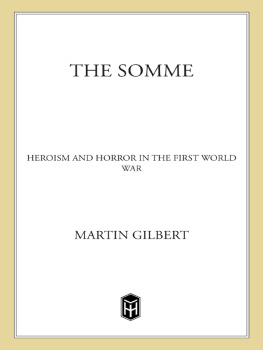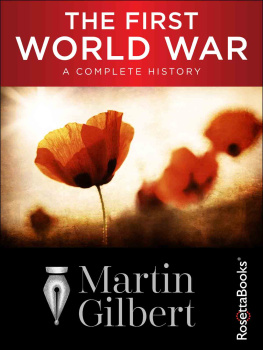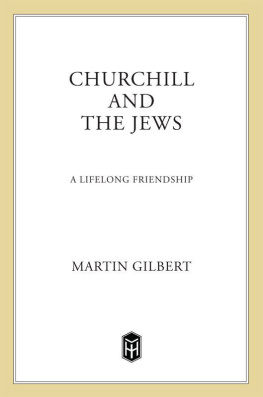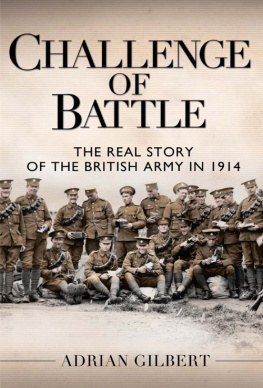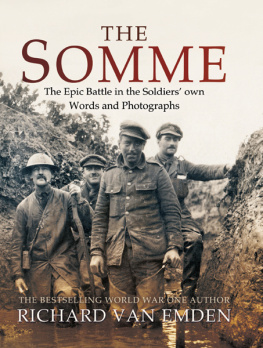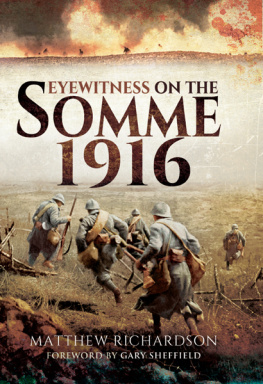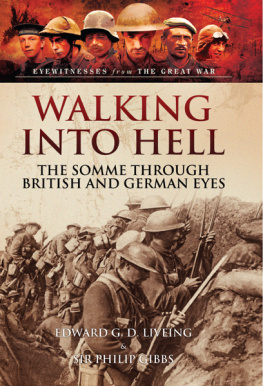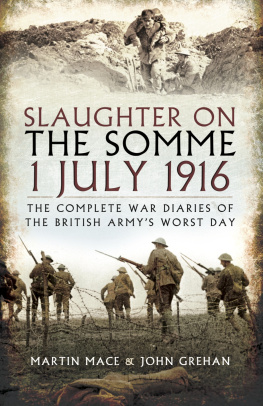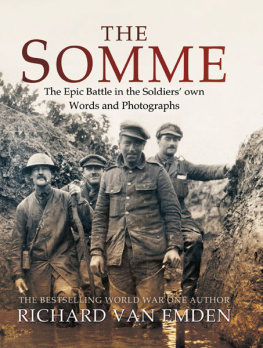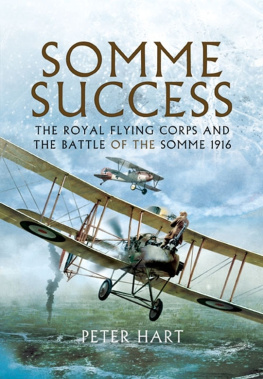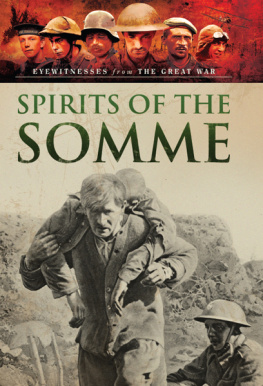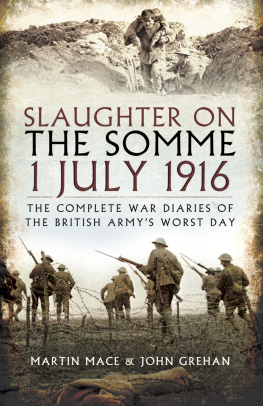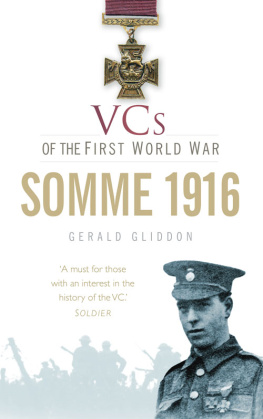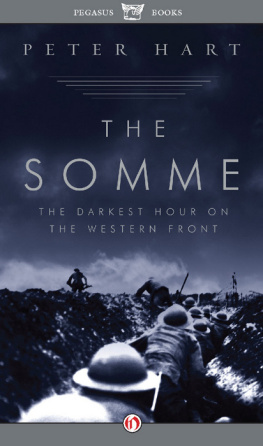Acknowledgements
W HILE A SCHOOLBOY in London more than half a century ago, thirty-five years after the Battle of the Somme, I was taught history at Highgate School by Arthur Preston White, who had served in the battle as a lieutenant and had written letters from the battlefield to his sister. Jumbo, as he was known, was in the habit in class of bursting into military song. From that time, as a fifteen-year-old, I had a curiosity about the battle. A decade later, in 1961, as a Junior Research Fellow at Merton College, Oxford, I heard about the Somme from another former lieutenant who had served there, J. R. R. Tolkien, a Fellow Emeritus of the college. Two years after that I had a number of conversations with A. P. Herbert, who had both fought on the Somme and written about his experiences.
I first visited the Somme in the 1970s, when I discussed the battle with several of those who were helping me with my work on the Churchill biography. Among them were three former Guards officers: Harold Macmillan, who had been seriously wounded on the Somme on 15 September 1916, and Field Marshal Earl Alexander of Tunis and Viscount Chandos, both of whom, as Captain Harold Alexander and Captain Oliver Lyttelton, were in the same fierce struggle that day. I also discussed the battle with Paul Maze, the French painter who served as a sergeant with the British forces on the Ancre in November 1916, and John Bentham, a veteran of the Royal Naval Division, who also fought in the November battle.
For help in the search for materials, I am particularly grateful to my friend Max Arthur; to Terry Charman, Historian, Imperial War Museum; to Richard Davies, Special Collections, Brotherton Library, Leeds University Library; to Gary Garrison; to Andrew Mackinlay, MP; to Professor Peter Neary; to Allen Packwood, Churchill Archives Centre, Churchill College, Cambridge; to George Palfrey; to the late A. J. Peacock, Editor of Gun Fire ; to Pawel Szymanski; to Vicky Wylde, Senior Collections Assistant, Imperial War Museum; and to Debbie Young, Somerset Military Museum. A special debt is due to Major and Mrs Holt (Tonie and Valmai Holt) for making the battlefield of the Somme accessible on the ground, wood by wood and cemetery by cemetery, to historians and visitors alike.
I am grateful to all those who gave me permission to quote from material that is their copyright. As it has not been possible to trace all the copyright holders, I apologize to those I have been unable to contact. Permission has been gratefully received for specific quotations and use of material from the National Archives, Kew; Churchill Archives Centre, Churchill College, Cambridge; the Imperial War Museum, London; Max Arthur; Eric Bogle; and Ron Venus.
My publishers have been supportive throughout: I would like to thank Jennifer Barth of Holt, New York; Doug Pepper and Chris Bucci at McLelland and Stewart, Toronto; and Roland Philipps and Caroline Westmore at John Murray, London; as well as Bob Davenport and Josine Meijer. For permission to reproduce the photographs I am grateful to the Imperial War Museum (Nos. 2, 421, 24, 2740, 44, 46 and 47), the Liddle Collection, Leeds University Library (42); and Popperfoto (1, 3, 22, 23, 256, 41, 43 and 45). Numbers 48 and 49 are my own.
For help during my most recent visit to the Somme, I would like to thank the staff at the Newfoundland War Memorial Park; the staff of the Ulster Tower caf and bookshop; Philippe Feret of the Beaucourt Station caf; Avril Williams and her staff at Auchonvillers Ocean Villasto the soldiers of 1916 and the almost always unseen yet in the most important sense ever-visible gardeners and keepers of the Commonwealth War Graves Commission, whose work and dedication have maintained so many places of repose on the Somme battlefield: my final maps show their locations.
As he has done for almost twenty years, Tim Aspden turned my rough drafts into maps of the highest quality. Kay Thomson was, as always, a font of indispensable help. My son David organized a journey to war memorials in the Leeds area. My wife, Esther, accompanied me on my most recent visit to the Somme, and has given good guidance.
To my teacher Alan Palmer, whose encouragement, beginning at school, has been consistent for more than fifty years, I dedicate this most recent assignment.
Preface
Even unto them will I give in mine house and within my walls a place and a name better than of sons and of daughters: I will give them an everlasting name, that shall not be cut off.
Isaiah 56:5
T HE BATTLE of the Somme was one of the most costly battles in the history of warfare. On the first day alone, 19,240 British soldiers were killed and more than 36,000 wounded. Between 1 July 1916, when it began at the height of summer, and 19 November 1916, when it ended in the snow and fog of winter, more than 300,000 British, Commonwealth, French and German soldiers had been killed, and twice that number wounded.
The area of the battlefield is small: fifteen miles in length and six miles at its greatest depth. Today it is an area of peaceful rolling hills, woods and cultivated fields, with its once obliterated villages rebuilt. It is also an area of scattered war cemeteries, and other memorials to the battle.
The largest of all the Western Front memorials is on the Somme: the Thiepval Memorial to the Missing. Inscribed on its massive columns are the names of 73,335 British and South African soldiers who were killed and whose bodies were never identified. The names of the other Commonwealth soldiers whose bodies were never identified, as well as the French and German, are on other memorials, further from where the battle was fought. French and German cemeteries are also a solemn feature of the Somme landscape: the German cemetery at Fricourt has 17,000 burials, of whom 12,000 lie in four mass graves.
What happened on the battlefield? Why was the battle fought in the first place? Why was it so prolonged, at such heavy cost? What was its impact on the wider war? These questions have haunted survivors of the battle, the relatives and friends of those killed, and those born long after it. Poets, historians, writers, novelists, journalists, film-makers, teachers and schoolchildren have been among those drawn to its story.
My most recent journey to the Somme was in November 2005, eighty-nine years after the last weeks of the battle. The battlefield, although much changed over ninety years, and much visited each year even more in the twenty-first century than before still has the power both to haunt and to inspire.

